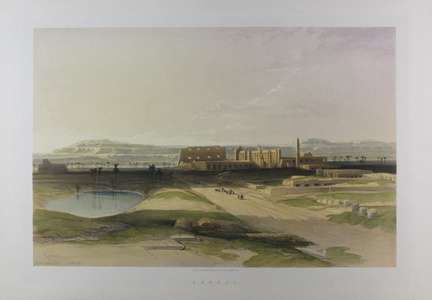| Method | Lithograph with tint stone and later hand colour |
| Artist | Louis Haghe after David Roberts |
| Published | London, Published by F.G. Moon, 20 Threadneedle Street, May 1st, 1847 |
| Dimensions | Image 325 x 490 mm, Sheet 422 x 608 mm |
| Notes |
A general view of the Temple Precinct of Amun Ra, in the city of Karnak, Egypt. The Karnak temple complex is one of the largest ancient religious sites in the world, comprising the Precincts of the gods Amun-Ra, Montu, and Mut, as well as a now dismantled temple of Amenhotep IV, better known as Akhenaten. The most substantial of these precincts is the Temple Complex of Amun-Ra, the state god of Egypt, and the principle deity of the Theban Triad. The complex is also one of the longest continually used religious sites in Egyptian history, having been founded during the Middle Kingdom, but added to and expanded continuously into the Roman era. The Hypostyle Hall was built during the reign of Seti I, and embellished by his son and successor, Ramesses II. When complete, the hall consisted of 134 massive columns and covered an area of 5000 square metres. Roberts' general view of the ruins of the Temple Complex show the Hypostyle Hall, the Obelisk of Hatshepsut, the massive walls of the First Pylon, and the colonnades of the temple courtyards. In the distance are the cliffs of the 'Wadi al-Muluk,' the famous Valley of the Kings in the heart of the Theban necropolis, the main burial site for the pharaohs of the New Kingdom. On the wide avenue leading to the site, two teams of camels move. To the left of this avenue, sporadic copses of palms are scattered around a small lake. David Roberts RA (24 October 1796 – 25 November 1864) David Roberts' monumental works on the Middle East: The Holy Land and Egypt & Nubia, is considered the greatest lithographically illustrated works issued in the 19th century. Roberts' masterpiece was issued in 41 parts over seven years in three states; tinted, tinted proof and coloured and mounted on card. The prints were masterfully lithographed by Louis Haghe, to whom Roberts paid tribute in glowing terms, `Haghe has not only surpassed himself, but all that has hitherto been done of a similar nature. He has rendered the views in a style clear, simple and unlabored, with a masterly vigor and boldness which none but a painter like him could have transferred to stone'. Abbey regarded the work as `one of the most important and elaborate ventures of nineteenth-century publishing, and.the apotheosis of the tinted lithograph'. David Roberts was born in Stockbridge near Edinburgh, and at the early age of 10 apprenticed to Gavin Buego, a house painter. He continued to work for Buego after his apprenticeship had been completed, carrying out work on imitation stonework and panelling at Scone Palace and Abercairney Abbey. By 1818 Roberts had become assistant scene painter at the Pantheon theatre in Edinburgh, moving on to work in theatres in Glasgow and finally in late 1821 to Drury Lane theatre in London, where he worked with Clarkson Stanfield. Both artists exhibited at the Society of British Artists, Royal Academy and British Institution, and by 1830 Roberts was firmly established as a topographical artist and was able to give up his theatre work. In these early years he toured the continent and Scotland, and in 1832-33 visited Spain. In 1838 he made plans for his journey to the Near East, inspired by a love of artistic adventure; departing in August 1839 for Alexandria, he spent the remaining part of the year in Cairo, visiting the numerous tombs and sites. In February of the following year he set out to cross the desert for the Holy Land by way of Suez, Mount Sinai and Petra arriving in Gaza, and then on to Jerusalem, concluding his tour spending several months visiting the biblical sites of the Holy Land, and finally returning to England at the end of 1839. The drawings of his tour were submitted to F.G. Moon in 1840 who arranged to bring out a work illustrative of Scripture History, paying Roberts £ 3,000 for the copyright of the sketches, and for his labour in supervising Louis Haghe's lithography. Both the exhibition of his original watercolours and the subsequent published work were an immediate success and confirmed his reputation as an architectural and landscape artist of the highest order. Abbey Travel 272, 75. Yesterday and Today: Egypt, 55. Condition: Light toning to paper, old tape reside on top of verso not affecting the recto or image. |
| Framing | framed |
| Price | £900.00 |
| Stock ID | 42678 |

